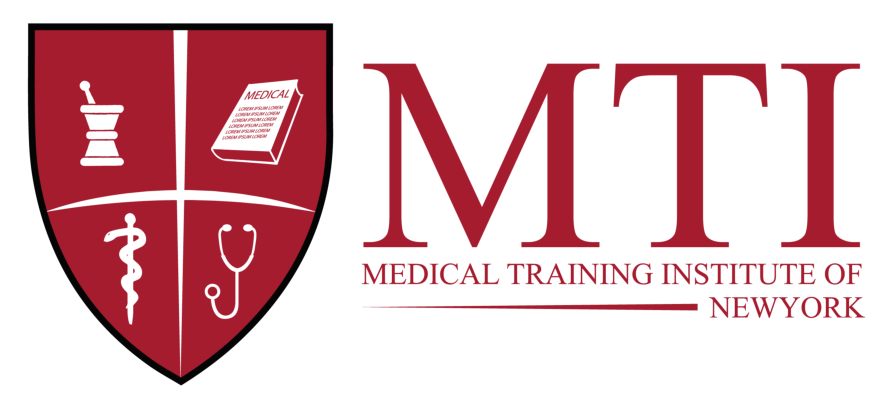
Advanced Medical Coding Specialist and Auditing
Course Overview
The Advanced Medical Coding and Auditing Program at Medical Training Institute of New York is designed to prepare students for careers in a variety of healthcare settings, including medical offices, hospitals, clinics, and skilled-care facilities.
This course focuses on application of coding principles learned in CPT/ICD coding. In this course, the student codes source documents that he or she can expect to encounter on the job. The student will analyze and synthesize source documents and apply ICD-10-CM, CPT, and HCPCS codes based on documentation.
Advanced Medical Coding and Auditing requires the student to apply previously learned coding in CPT, HCPCS, and ICD-10-CM concepts to a wide array of medical reports. The student is presented with more in-depth coding information on a topic, such as coding pacemaker implantation, and then the student applies the knowledge by assigning CPT, HCPCS, and ICD-10-CM codes to the services and procedures from an original source document. The student uses an audit form and assigns the correct level of E/M services based on documentation.
Advanced Medical Coding and Auditing, presents the student with coding practice that simulates the type and complexity of reports the student will encounter on the job.
Auditing Review reports are available for each chapter on Evolve. The reports simulate the type of auditing tool the student will need on the job.
Program Summary
Course overview
We are still updating our website with contents. Please check back next time.
Program Schedule Guidelines
We are still updating our website with contents. Please check back next time.
MTI Mission & Goals
We are still updating our website with contents. Please check back next time.
Program Curriculum
We are still updating our website with contents. Please check back next time.
Grading Scale and Methods of Evaluation
We are still updating our website with contents. Please check back next time.
Admission
We are still updating our website with contents. Please check back next time.
Tuition, Books & Technology Fees
We are still updating our website with contents. Please check back next time.
Paying For Your Program
We are still updating our website with contents. Please check back next time.
Refund Policy
We are still updating our website with contents. Please check back next time.
Textbooks
| 1. Buck's Step-by-Step Medical Coding, 2022 Edition | ISBN: 9780323790383 | |||
| 2. Buck's Workbook for Step-by-Step Medical Coding, 2019 Edition Elsevier eBook on VitalSource | ISBN: 9780323582537 | |||
| 3. Buck's The Next Step: Advanced Medical Coding and Auditing, 2021/2022 Edition | ISBN: 9780323764452 | |||
| 4. Buck's The Next Step: Advanced Medical Coding and Auditing, 2021/2022 Edition - Elsevier E-Book on VitalSource | ISBN: 9780323764438 | |||
| 5. Buck's Simulated Medical Coding Internship | ISBN: 9780323792547 | |||
Instructor
We are still updating our website with contents. Please check back next time.
Competency-Based Instruction
Competency-based instruction focuses on the mastery of skills that will be used as part of a professional coding practice.
Competency-Based Instruction will:
- Focus on student learning and performance rather than on instruction, teaching techniques, textbooks, and instructor activity.
- Emphasize student mastery of skills, habits, and attitudes that represent actual job requirements and situations.
- Give students opportunities to problem-solve and apply information and skills.
- Require students to demonstrate knowledge and skills in ways that are observable to both themselves and instructors.
- Shift the focus of the traditional classroom from teacher performance to student performance, from teaching to learning, from instructors presenting to students presenting, and from instructors teaching to instructors guiding students as they teach themselves.
- Present program content that is based on actual workplace application of the material being covered. This requires an integrated education structure in which all material, theory, ethics, practical application, and so forth are interrelated instead of taught as separate ideas.
- Require the active involvement of students in the learning process instead of only passive
Competency-Based Lessons:
- Are built on actual career expectations and applications.
- Include performance activities as early in the program as possible.
- Require students to think and perform like actual coding professionals.
- Provide students with opportunities to create, problem-solve, and develop solutions.
- Teach students how to monitor and evaluate their own performance instead of relying only on instructor evaluations.
- Provide an opportunity for students to be active participants during classroom time.
- Minimize instructor lectures and maximize student study groups, small-group work in the classroom, individual or group presentations, and projects.
- Emphasize hands-on practical application of the material.
Competencies for the Professional Practice of Medical Coding
In general, the competencies required for a successful practice of medical coding fall into four areas:
- Service coding with CPT and HCPCS
- Diagnosis coding with ICD-10-CM
- Reimbursement issues
- Application of terminology, anatomy, physiology, and pathophysiology skills Service coding involves the facts, concepts, and theories presented in the textbook about the Current Procedural Terminology (CPT) and Centers for Medicare and Medicaid Services’ Healthcare Common Procedure Coding System (HCPCS) and application of the service codes and modifiers.
Diagnosis coding uses the ICD-10-CM to report the diagnosis for which the patient received services.
Admission Requirement: GED/High School DiplomaWHAT YOU'LL LEARN
The students will apply CPT, HCPCS, and ICD-10-CM codes to a wide variety of subspecialty areas:
- Evaluation and Management Services
- Medicine
- Radiology
- Pathology and Laboratory
- Integumentary System
- Cardiovascular System
- Digestive System, Hemic/Lymphatic System, and Mediastinum/Diaphragm
- Musculoskeletal System
- Respiratory System
- Urinary, Male Genital, and Endocrine Systems
- Female Genital System and Maternity Care/Delivery
- Nervous System
- Eye and Auditory Systems
- Anesthesia
WHO WILL BENEFIT

Those Considering Coding and Auditing
Coding is a great career choice for anyone who wants to be in a non-patient-facing position within the healthcare industry. It also offers the benefits of working from home and having a very flexible schedule
Coders can work in various settings including hospitals. outpatient clinics, urgent care facilities, nursing homes, treatment centers, physician offices, and insurance companies. There are also multiple outsourcing agencies that employ coders to work remotely for a variety of clients.

Aspiring Medical Professionals
Working as a Coder gives many of us our first taste of working in the medical field. You might gain inspiration to continue that career path and get a more in-depth understanding of the medical world. It's okay to share this desire with your interviewer. It shows your dedication to the field and a willingness to learn

Job Stability
The demand for medical coders is growing. In fact, the Bureau of Labor Statistics expects this field to grow by 22% through 2026, About 34,300 openings for medical records and medical coding specialists are projected each year, on average, over the decade. Many of those openings are expected to result from the need to replace workers who transfer to different occupations or exit the labor force, such as to retire
PROGRAM STRUCTURE
Length of Curriculum: 750 Clock hours
The 750 clock hours of the Advanced Medical Coding Specialist consist of 450 hours of Didactic, 150 hours of Lab, 150 hours of Internship.
| Program Type | Learning Modality | Hours |
| Advanced Medical Coding & Auditing Specialist |
|
|
| Total Hours | 750 |
FALL 2023
Fall 2023 Enrollment Open
Program Length: 33-41 weeks
Tuition Cost: $4,800
Apply NowThis course is also part of our Medical Billing and Coding — consisting of Medical Coding Specialist
Advanced Medical Coding and Auditing
Advanced Medical Coding and Auditing requires the student to apply previously learned coding in CPT, HCPCS, and ICD-10-CM concepts to a wide array of medical reports. The student is presented with more in-depth coding information on a topic, such as coding pacemaker implantation, and then the student applies the knowledge by assigning CPT, HCPCS, and ICD-10-CM codes to the services and procedures from an original source document. The student uses an audit form and assigns the correct level of E/M services based on documentation.
The students will apply CPT, HCPCS, and ICD-10-CM codes to a wide variety of subspecialty areas:
- Evaluation and Management Services
- Medicine
- Radiology
- Pathology and Laboratory
- Integumentary System
- Cardiovascular System
- Digestive System, Hemic/Lymphatic System, and Mediastinum/Diaphragm
- Musculoskeletal System
- Respiratory System
- Urinary, Male Genital, and Endocrine Systems
- Female Genital System and Maternity Care/Delivery
- Nervous System
- Eye and Auditory Systems
- Anesthesia
Advanced Medical Coding and Auditing presents the student with coding practice that simulates the type and complexity of reports the student will encounter on the job
Auditing Review reports are available for each chapter. The reports simulate the type of auditing tool the student will need on the job.
Instructors:
1. Donna A. Castellano
2. Christine Manookian
3. Dian Johnson
Simulated Medical Billing and Coding Internship
Simulated Medical Coding Internship prepares students to code accurately and efficiently in a professional setting. More than 600 cases in 18 medical specialties offer a realistic simulation of the workload in a multi-specialty medical clinic. This simulated coding internship complements and provides application for the concepts learned in Medical Coding Program and Advanced Medical Coding and Auditing. Best of all, students can save a portfolio of the coding cases they’ve completed to prove proficiency to potential employers
Internship or Externship
An on-the-job internship or externship enhances the student's ability to obtain employment. If an on-the-job experience is not available to your students, consider a simulated internship by means of an online experience. This online experience exposes the student to the on-the-job workload in the online environment.
Coding Exam Review
With the ever-increasing complexity of medical coding, employers are giving preference to those coders who are well prepared and certified. MTINY prepares students for the physician and facility certification examinations and includes a review of terminology, anatomy/physiology, reimbursement, compliance, CPT, HCPCS, and ICD-10-CM coding. The material is presented in outline form with multiple Pre/Post Examinations and Final Examination options.
Credentials
Certification
The medical coding profession is in an ongoing, active process of certification. Most facilities require the medical coder to have a certification. The Certified Professional Coder (CPC) administered by the American Academy of Professional Coders, and the Certified Coding Specialist (CCS) and Certified Coding Specialist - Physician (CCS-P) administered by the American Health Information Management Association, provide focal points for the development of these courses, whether in the private or public sector of education. For further information about the American Academy of Professional Coders, visit the website at www.aapc.com and for information about the American Health Information Management Association, visit the website at www.ahima.org. The certifying organizations suggest that the coder have coding experience before taking the certification examination, but this is not a requirement. Many students successfully take the exam immediately after graduation. The graduate who is successful on the CPC examination but does not have the required years of practical experience is required to use the apprentice designation, CPC-A. Employers usually give merit pay for the certified coder designation
Program Curriculum
Curriculum Summary
DOWNLOAD CURRICULUM (PDF)| Units | Modules | Clinical Lab Skills | Takeaways |
UNIT 1 Pre-requisites |
|
|
| Units | Modules | Clinical Lab Skills | Takeaways |
UNIT 2 Reimbursement |
|
|
|
THE MTI ADVANTAGE
- Experience Faculty and Staff
- 100% Medical and Healthcare Programs
- State-of-the-Art Medical Equipment’s
- All instructors are Practitioners as well as Instructors in their field
- Workshops to enter the Workforce
- Guaranteed Internships/Externships (Hands-on Training)
- Affiliated with top Hospitals and clinics
- Career Development Skill
- Job placement Assistant
Total Program Cost
| Program | Advanced Medical Coding & Auditing Specialist |
| Hours | 750 |
| Registration Fee | $100 |
| Tuition | $4,800 |
| Technology Fees | $480 |
| Clinical Lab Fee | $350 |
| Total Program Cost | $5,730 |
Fees:
Registration Fee
A non-refundable Registration Fee of $100 was due during registration to reserve a seat.

Clinical/Lab Fee
Clinical/Lab Fee is used to cover the cost of Liability insurance policy and student lab operations and to provide students with Liability Insurance at clinical rotation internship sites.

Technology Fees:
Technology Fee provides students with Online Learning Resources, the learning management system, and the student portal.

Books:
Students are required to purchase all textbooks on their own. Textbook costs are estimated at $700.

Uniform Fee
Students are required to purchase MTI logo scrubs on their own. MTI logo scrubs can be purchased from the school bookstore or online at portal.mtiofnewyork.com/stores.

Tuition:
Advanced Medical Coding & Auditing Specialist is $1,910 for each of the program's three (3) quarters, and a total of $5,730 for the entire program, with tuition payments due as follows:

| Quarter | Hours | Cost Per Quarter |
| 1 | 250 | $1,877 |
| 2 | 250 | $1,877 |
| 3 | 250 | $1,877 |
Schedule of Sessions
9:00AM-1:15PM
Morning Classes
The Morning program will be 4 hours per day Monday- Friday.
20 hours per week for approximately 39 weeks.
1:00 PM- 5:45 PM
Afternoon Classes
The Afternoon program will be 4 hours per day Monday- Friday.
20 hours per week for approximately 39 weeks.

